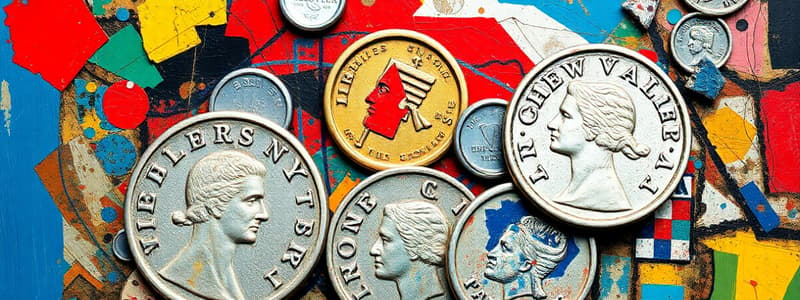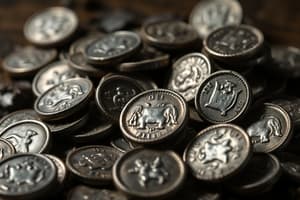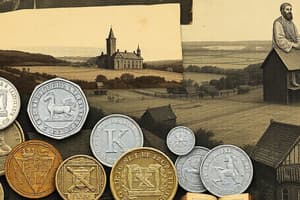Podcast
Questions and Answers
The Chew Valley Hoard is believed to have been buried due to which historical context?
The Chew Valley Hoard is believed to have been buried due to which historical context?
- A widespread famine that caused economic instability.
- The construction of new cathedrals requiring mass relocation of valuables.
- The coronation of William I as the new King of England.
- Rebellions against William I and attacks by Harold's exiled sons. (correct)
What does the practice of some coins being cut in half from the Chew Valley Hoard indicate about monetary practices of the time?
What does the practice of some coins being cut in half from the Chew Valley Hoard indicate about monetary practices of the time?
- Coins were intentionally defaced to protest the Norman Conquest.
- Cutting coins was done for religious ceremonies and offerings.
- It was a method to create smaller denominations of currency. (correct)
- Damaged coins were split to separate the silver for other uses.
What is the primary significance of the Chew Valley Hoard for historians?
What is the primary significance of the Chew Valley Hoard for historians?
- It confirms the location of the Battle of Hastings with greater accuracy.
- It demonstrates the wealth of farmers in 11th-century England.
- It provides insights into the economic and political transition following the Norman Conquest. (correct)
- It reveals the preferred artistic styles of Anglo-Saxon and Norman royalty.
How was the value of the Chew Valley Hoard estimated in terms of commodities from the time it was buried?
How was the value of the Chew Valley Hoard estimated in terms of commodities from the time it was buried?
Which event directly preceded the minting of the coins in the Chew Valley Hoard, making the hoard historically significant?
Which event directly preceded the minting of the coins in the Chew Valley Hoard, making the hoard historically significant?
What was Adam Staples' initial indication that the coins he found were of significant historical value?
What was Adam Staples' initial indication that the coins he found were of significant historical value?
Besides Adam Staples and his friends, who else received a portion of the $5.5 million from the sale of the Chew Valley Hoard, and why?
Besides Adam Staples and his friends, who else received a portion of the $5.5 million from the sale of the Chew Valley Hoard, and why?
Where will the Chew Valley Hoard be permanently housed after its tour across the UK?
Where will the Chew Valley Hoard be permanently housed after its tour across the UK?
Flashcards
Chew Valley Hoard
Chew Valley Hoard
A collection of 2,584 silver pennies discovered in Somerset, England, dating back to the 11th century.
1066-1068
1066-1068
The year the Chew Valley Hoard coins date from, representing a turning point after the Norman Conquest.
King Harold II
King Harold II
The last Anglo-Saxon king of England, defeated in 1066.
William I (the Conqueror)
William I (the Conqueror)
Signup and view all the flashcards
Cut Coins
Cut Coins
Signup and view all the flashcards
500 Sheep
500 Sheep
Signup and view all the flashcards
South West Museum of Somerset
South West Museum of Somerset
Signup and view all the flashcards
Landowner's share
Landowner's share
Signup and view all the flashcards
Study Notes
- In January 2019, Adam Staples and his friends discovered a trove of silver coins in Chew Valley, Somerset, England while testing a new metal detector.
- The find is now known as the Chew Valley Hoard.
- The hoard consists of 2,584 silver pennies dating back to the 11th century.
- On October 23, 2024, the South West Heritage Trust purchased the coins for $5.5 million.
- This purchase made it Britain's most valuable treasure find on record.
- Staples and his friends will receive half the money, with each taking home about $400,000.
- The owner of the land where the coins were found will receive the other half, approximately $2.8 million.
- The coins date from 1066 to 1068
- The coins are believed to have been minted at 46 different locations in England.
- The coins represent a turning point in England's history, following the Norman Conquest of 1066.
- The Norman Conquest in 1066 marked the defeat and death of King Harold II by William I.
- Roughly half the coins bear King Harold's image, while the other half feature William I.
- William I ruled England until 1087.
- Experts believe the coins were buried for safekeeping due to rebellions against William I.
- In 1068 the people of Exeter rebelled against William.
- King Harold's sons mounted attacks from Ireland along the River Avon down into Somerset.
- Some of the coins are cut in half which was a common practice to create smaller units of money.
- Gareth Williams estimates the Chew Valley Hoard was worth about 500 sheep or the annual income of a large estate.
- The Chew Valley Hoard will tour museums across the UK, starting with the British Museum in London in November 2024.
- The coins will then be permanently housed at the South West Museum of Somerset.
Studying That Suits You
Use AI to generate personalized quizzes and flashcards to suit your learning preferences.





